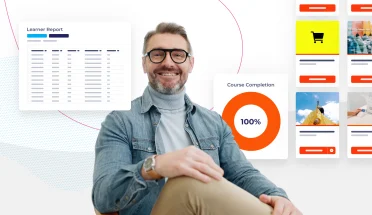Not that long ago, in a galaxy, well, right here, learning management systems were something that were out of the reach of small and medium-sized organizations. They were expensive to license, cost a fortune to implement and often took 6-months or more for setup, training, configuration, and customization. The payoff? Interfaces were clunky and dated, and LMS administrators would have to go through extensive onsite training to learn how to do a basic course and user management. And reports? You would have to call your vendor for the slightest modifications.
Fast forward to today. There are hundreds on the market now. Some of those clunky old systems are still around (maybe with a face-lift or two), and a host of feature-simple, budget systems have come onto the market. There are more options than ever, and thousands of organizations want to put their first LMS in place to better manage all of their training and compliance requirements.
Now that management has approved the budget for your first learning management system you can say "Goodbye" to your Microsoft Excel training spreadsheet!
With your LMS implementation underway, and on its way to completion in as little as 4-6 weeks, here are some suggestions for planning a smooth and successful implementation:
Plan for your LMS implementation by thinking of your training in terms of Who, Why, What, Where, and When.
Who?
Who are your Learners? What differentiates them from a training perspective? This might be any combination of criteria such as:
- Job title
- Department
- Branch or office location (store #, plant, etc.)
- or Pay level.
Or if you are training externally, is it:
- Partner type
- Reseller status
- Customer type
- Product line
- or Membership level.
The same thinking applies to your Administrators. Who are they? Supervisors, managers, course editors, external managers, etc. Who do they need to see in the LMS reports and for actions like managing Enrollments and Competency administration?
The above lists are all examples of values that can be stored in standard or custom User Profile Fields, or can help you to decide how you want to organize your users into Departments and/or Groups. You will need to decide on your user taxonomy before you import or add your first learners into the system. If you can get this right the first time, it will make a huge difference to how effectively you use your LMS. The more quality information you have stored in your user profiles, and the better defined your user taxonomy is, the easier it will be to target content at different sets of learners and to get accurate, detailed reporting.
Why?
Why are you training these different audiences? Is it for health and safety or other industry compliance? Is it for new hire onboarding? Is it for job-specific skills training? Is it for career development?
This will help you to figure out how to set your enrollment rules in the system, and to a certain extent, how to set up your reports. For example, if you know that all Warehouse employees need to take a Forklift Safety Course, then you can set an automatic enrollment rule based on Department (Warehouse) and/or Job Title. Automatic enrollment rules are tremendous time savers for any standard learning requirements, and they can also reduce your risk of falling out of compliance.
Answering the question "Why?" will also help you to decide if something merits a certification of completion, certification renewal periods and/or competency awards. This will also help you to make decisions around customizing email notifications and setting due dates and reminders.
What?
Odds are you already have training content. If you take an inventory, you will likely find that you have a lot of content in Word or PowerPoint format and maybe even in video format. Depending on your budget, your available resources, and skills with authoring tools, you can either upload your documents as PDFs, add videos, and create assessments directly in the LMS. Or you can start to put all of this content through an authoring tool such as Articulate Storyline, and produce "slick" interactive courses published to industry standard formats such as AICC, SCORM, Tin Can or xAPI.
This is actually a topic that requires much further discussion but, in general, you can think of it this way: if you want to get going quickly, you can do some basic conversions and get started with your existing content, then improve it over time. There are lots of companies that can be hired to help with converting static content into multi-media interactive courses if that's important to you. Additionally, there are lots of companies that sell off-the-shelf courses for common business training subjects which can also be loaded into the LMS.
If your LMS supports live training (as Absorb LMS does), you can think about simply creating your live training in the LMS and using it for registrations and attendance tracking, or you can start thinking about which live courses you may want to convert to self-paced courses. Some courses may be best suited to a face-to-face or live virtual delivery format. But those that can work well in a self-paced format offer an opportunity to really reduce training delivery costs and employee time.
Where?
It's good to think about where your learners are and how they will be accessing training. Are they remote? Are they mostly on mobile devices? Do they have poor internet connection speeds? Do they need content in more than one language? These are just some of the considerations that will help you to make decisions around the best formats in which to deliver your training content and how you might want to "chunk up" your training.
When?
When do your learners need to get trained? This will vary by learner type and the nature of the course. Thinking about this will help to you decide things like:
- When to use Automatic vs. Self-Enrollment Rules
- When to set Post-Enrollment Rules and how to configure their timing
- When to use Curricula structures (learning paths)
- When to set Due Dates and/or Expiration Dates
- How often to schedule automated email reports.
I hope this gives you some simple but useful ways in which to think about how you want to approach your first LMS implementation. Of course, our veteran team here at Absorb LMS would be very happy to speak with you about any of these ideas, review your use case in more detail and provide recommendations for how Absorb LMS can be used to really improve your training efficiency and effectiveness.



